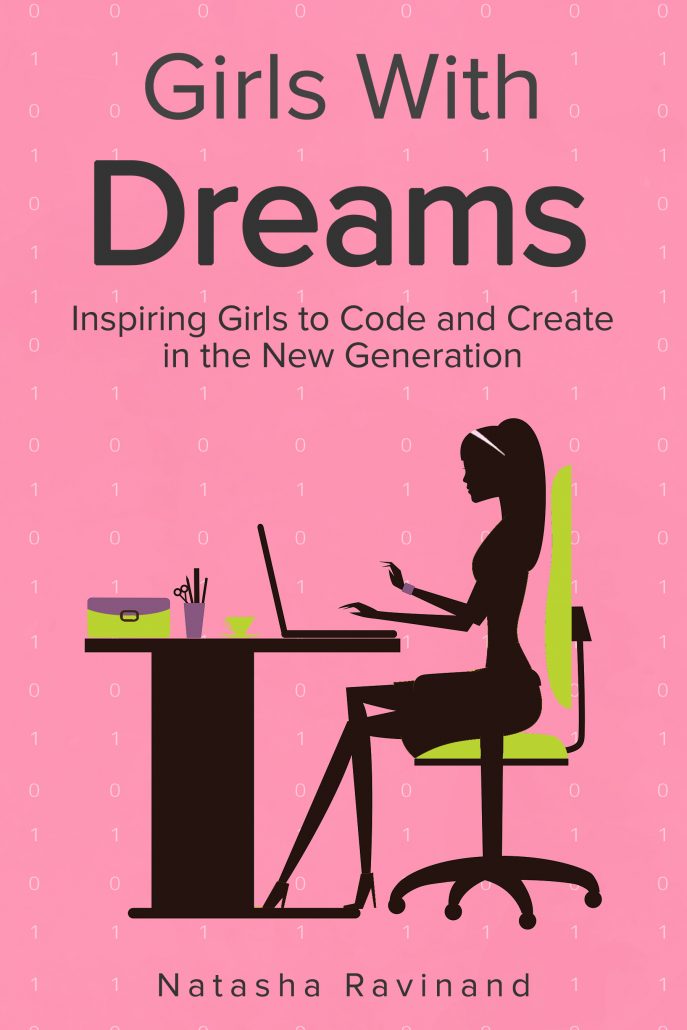The statistics are staggering: only 29% of all science and engineering workers are female, and far less are minorities. A high school junior with a passion for STEM (Science, Technology, Engineering, and Math), Natasha Ravinand has dedicated most of her teen life to closing the gender gap in tech. Natasha was named one of the top 50 influential high-schoolers in the world, and founded She Dreams in Code, a nonprofit organization dedicated to increasing coding opportunities for middle school girls. Natasha is the author of Girls With Dreams: Inspiring Girls to Code and Create in the New Generation, where she analyzes societal biases that widen the gender gap in the sciences, obstacles in the way of systemic change, and solutions for a better and more inclusive tomorrow. YEM spoke with Natasha about her book and her efforts to encourage girls to participate in STEM.
Young Entertainment Mag: At what age did you start becoming interested in STEM?
Natasha Ravinand: I began to take on an interest in STEM at around age 7. My parents had bought me a small robotics kit as a Christmas gift – I instantly became obsessed it. Long nights were spent tinkering around with random computer chips and wires. Until about 6th grade, I showcased an interest in STEM, being an avid participant in my sciences classes at school. In team projects, I would take charge and direct my peers to success, perhaps to the chagrin of some of my male peers. Outside of school, I joined STEM extracurriculars such as Scratch programming and robotics creation.
YEM: Tell us about you involvement with creating coding opportunities for middle school girls.
Natasha: I have written “Girls With Dreams”, a nonfiction book about the gender gap in STEM and how it might be mitigated in the future. In addition to this, I have also founded a nonprofit, She Dreams in Code (www.shedreamsincode.org) in order to distribute educational materials to underprivileged youth centers, specifically targeting young women, across the United States. I also write on a website called A Girl in Tech (www.natasharavinand.com), which hopes to provide girls a place to gather information on the current status quo in technology.
YEM: What is it like to have your own book at such a young age?
Natasha: It is certainly surreal to have a book published and available to buy everywhere! It’s an incredible opportunity that I believe has the potential to reach thousands across the country and the world. It’s been amazing seeing the book on track to reach its fullest potential.
YEM: Since you began your work, have you seen positive change in the field of gender equality?
Natasha: True change, I believe, is extremely gradual. There has, however, been much progress from when I’ve started my work to now. For example, I’ve seen Google’s efforts on trying to eradicate gender bias from the technical workplace following the aftermath of the infamous Damore manifesto. Other companies spearheaded by smart, innovative female leaders (ex. CEO Whitney Wolfe Herd of Bumble) have been expanding and promoting a positive culture of equality and equitability. However, it is going to take more than a few years for our notions on gender bias to fade away; till then, these bits of progress are essential and promising.
YEM: What would you tell young women who want to get into STEM?
Natasha: It’s going to be hard and, sometimes, it’s going to be unnerving. But that shouldn’t stop you – it should push you! We’re in this together, and it’s going to take our combined strength as well as the strength of our male allies to break the molds of gender bias in the technical landscape, and therefore cultivate a productive, fruitful development environment. Don’t worry about ‘the guys’ – focus on making yourself a person who’s not afraid to make mistakes and lead the way.
YEM: Is there anything you think parents should know when it comes to encouraging their daughters?
Natasha: I believe it’s just as important to encourage the daughters to pursue STEM as it is to teach our sons that STEM is for everyone. Often times we forget that this culture of perpetrating gender biases stems from men and women alike. Therefore, it’s only appropriate that we approach both young boys and girls with the same mindset – that STEM isn’t a boy’s activities. It’s essential to motivate (interested) girls to pursue the sciences, and it’s also equally essential to urge cooperation between both boys and girls in STEM-related activities. Influencing collaboration at a young age creates a more inclusive culture in later years.
YEM: What is the next step in moving towards equality in STEM?
Natasha: I believe the next step starts with each and every one of us. As a member of the younger generation, my peers have the ability to radically the change the ‘boy’s club’ culture of technology. However, all of us hold our unique roles in the modern world, with varying degrees of influence and different connections. If we begin with us, as individuals, to change our own gender biases, then in turn, we may be able to foster a more ideal utopia where all are welcome in STEM.





